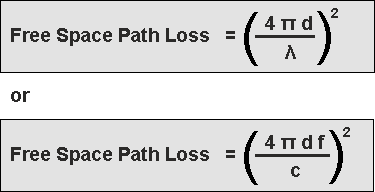The free space path loss, FSPL, is used in many areas for predicting radio signal strengths that may be expected in a radio system.
Although the free space path loss does not hold for most terrestrial situations because of other effects from the ground, objects in the path and the like, there are still very many situations in which it can be used. It is also useful as the basis for understanding many real life radio propagation situations.
Accordingly, the free space path loss, FSPL, is an essential basic parameter for many RF calculations. It can often be used as a first approximation for many short range calculations. Alternatively it can be used as a first approximation for a number of areas where there are few obstructions. As such it is a valuable tool for many people dealing with radio communications systems. In addition to this, these free space path loss, FSPL, calculations can be used in wireless survey tools where the free space loss is calculated and other scenarios added to provide an overall view of the signal strength at a given point. With the growing requirements to be able to analyse wireless or radio coverage, wireless survey tools are being used increasingly to enable coverage to be predicted at the early stages of design. Accordingly these wireless survey tools are being used increasingly in the development and installation of radio and wireless systems.
Free space path loss basics
The free space path loss, also known as FSPL is the loss in signal strength that occurs when an electromagnetic wave travels over a line of sight path in free space. In these circumstances there are no obstacles that might cause the signal to be reflected refracted, or that might cause additional attenuation.
The free space path loss calculations only look at the loss of the path itself and do not contain any factors relating to the transmitter power, antenna gains or the receiver sensitivity levels. These factors are normally address when calculating a link budget and these will also be used within radio and wireless survey tools and software.
To understand the reasons for the free space path loss, it is possible to imagine a signal spreading out from a transmitter. It will move away from the source spreading out in the form of a sphere. As it does so, the surface area of the sphere increases. As this will follow the law of the conservation of energy, as the surface area of the sphere increases, so the intensity of the signal must decrease.
As a result of this it is found that the signal decreases in a way that is inversely proportional to the square of the distance from the source of the radio signal in free space.
Whilst the free space path loss is taken to be inversely proportional to the square of the distance, in most terrestrial (non-free space) cases this basic formula has to be altered because of the effects of the earth and obstacles including trees, hills, buildings, etc.. In these cases the exponent value is typically in the range of 2 to 4. In some environments, such as buildings, stadiums and other indoor environments, the path loss exponent can reach values in the range of 4 to 6. In other words for the very worst case scenarios the signal may fall as the distance to the power six.
Tunnels which can act as a form of waveguide can result in a path loss exponent values of less than 2.
As an example many cellular operators base their calculations for terrestrial signal reduction around the inverse of the distance to the power 4.
Free space path loss formula
The free space path loss formula or free space path loss equation is quite simple to use. Not only is the path loss proportional to the square of the distance between the transmitter and receiver, but the signal level is also proportional to the square of the frequency in use for other reasons explained in a section below.
Where:
FSPL is the Free space path loss
d is the distance of the receiver from the transmitter (metres)
λ is the signal wavelength (metres)
f is the signal frequency (Hertz)
c is the speed of light in a vacuum (metres per second)
FSPL is the Free space path loss
d is the distance of the receiver from the transmitter (metres)
λ is the signal wavelength (metres)
f is the signal frequency (Hertz)
c is the speed of light in a vacuum (metres per second)
The speed of light is 2.99792458 x 10^8 metres per second, although for most practical purposes, this is taken to be 3 x 10^8 metres per second.
The free space path loss formula is applicable to situations where only the electromagnetic wave is present, i.e. for far field situations. It does not hold true for near field situations.
Free space loss formula frequency dependency
Although the free space loss equation given above seems to indicate that the loss is frequency dependent. The attenuation provided by the distance travelled in space is not dependent upon the frequency. This is constant.
The reason for the frequency dependence is that the equation contains two effects:
- The first results from the spreading out of the energy as the sphere over which the energy is spread increases in area. This is described by the inverse square law.
- The second effect results from the antenna aperture change. This affects the way in which any antenna can pick up signals and this term is frequency dependent.
As one constituent of the path loss equation is frequency dependent, this means that there is a frequency dependency within the complete equation.










No comments:
Post a Comment